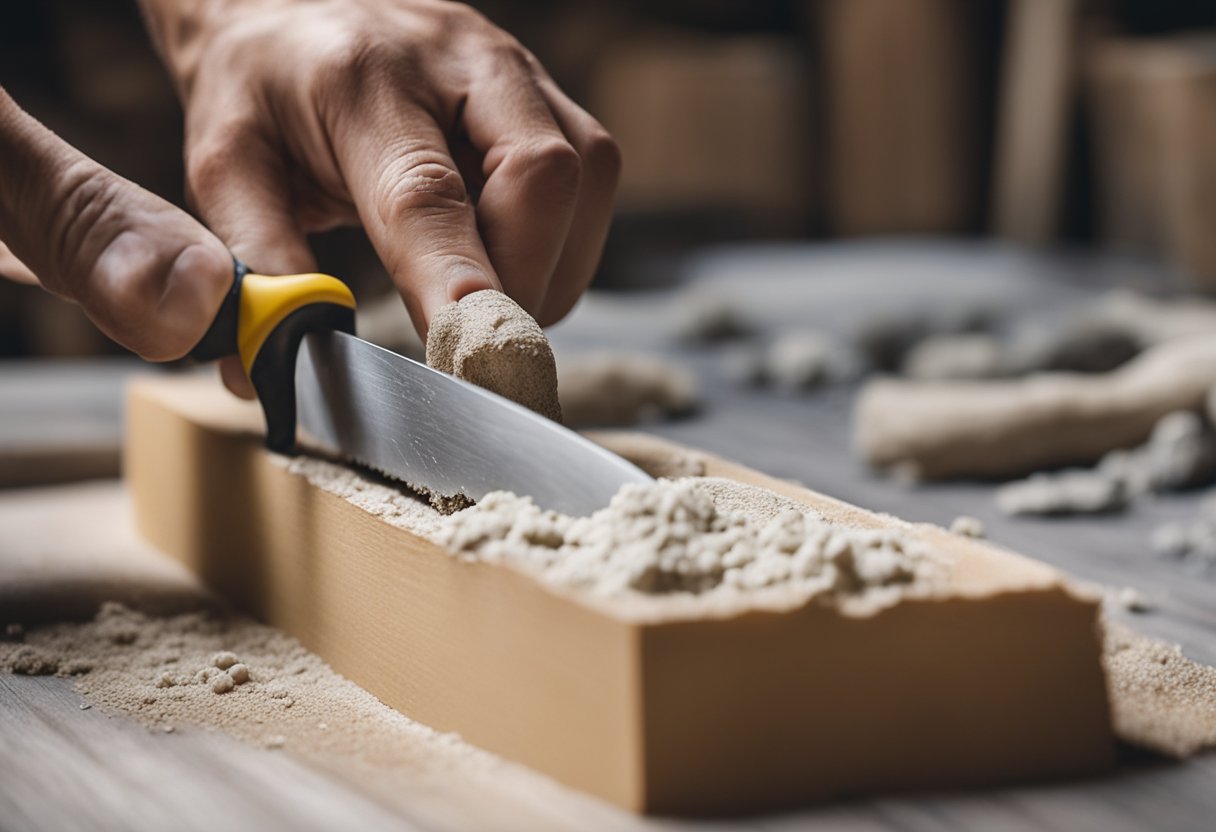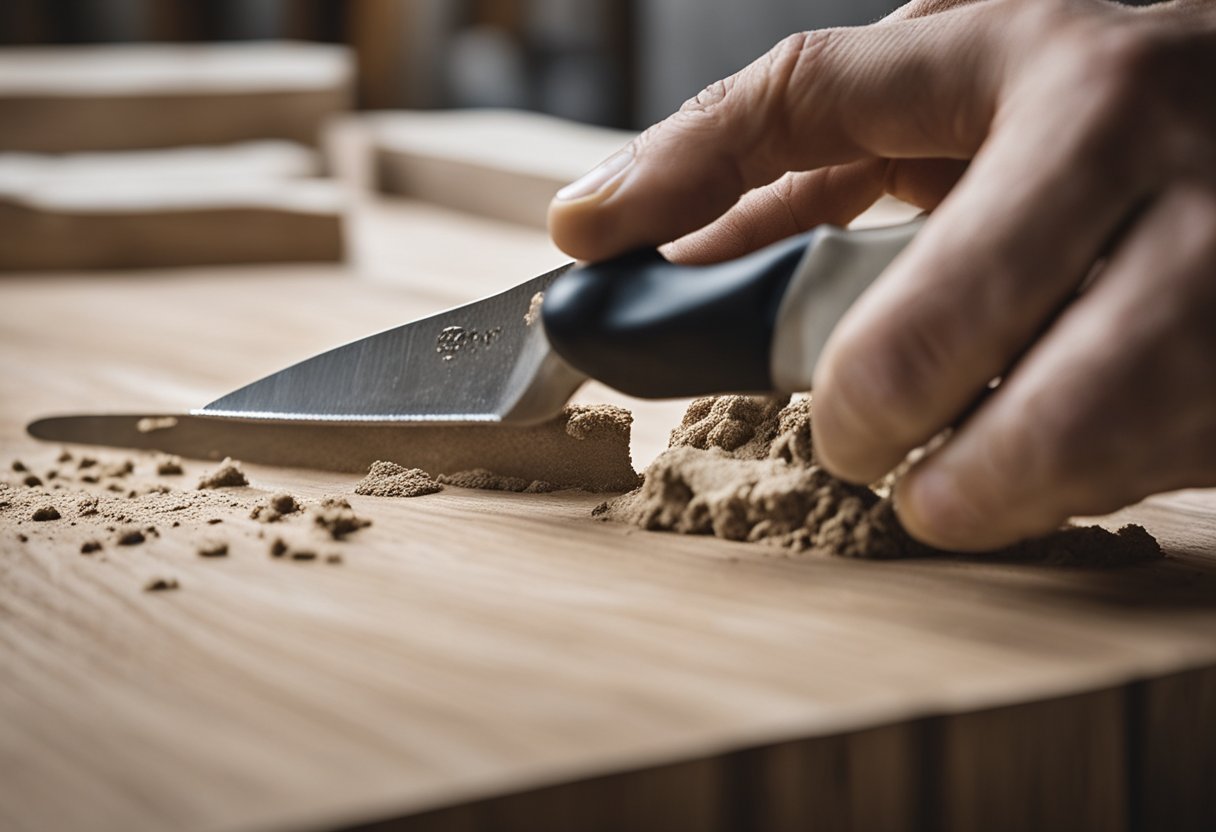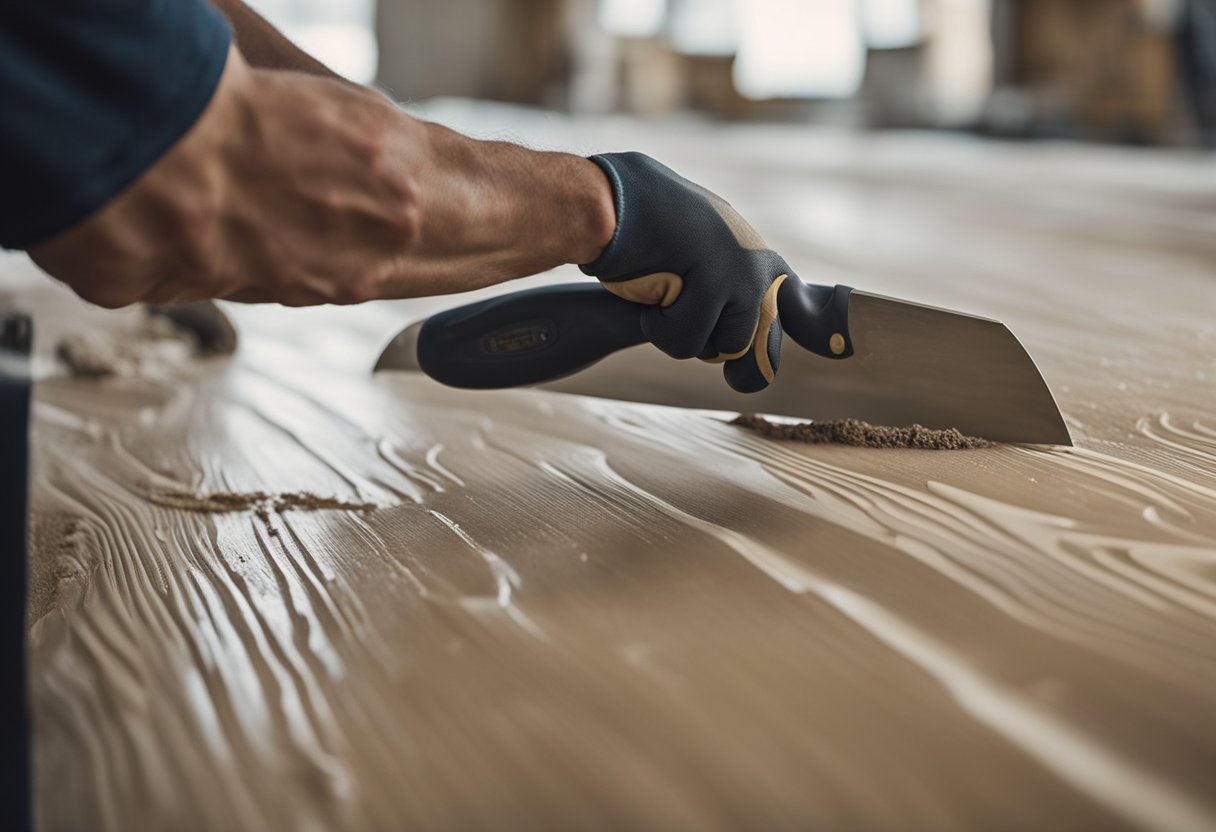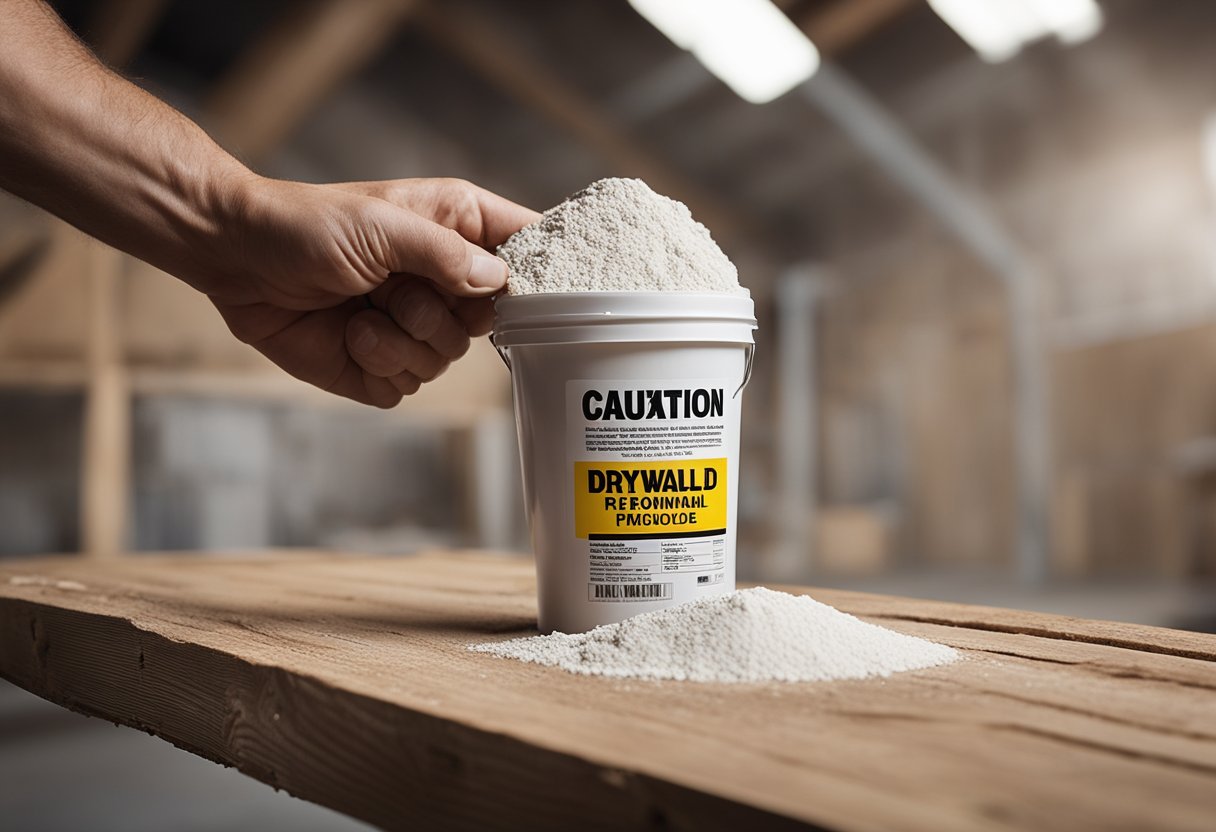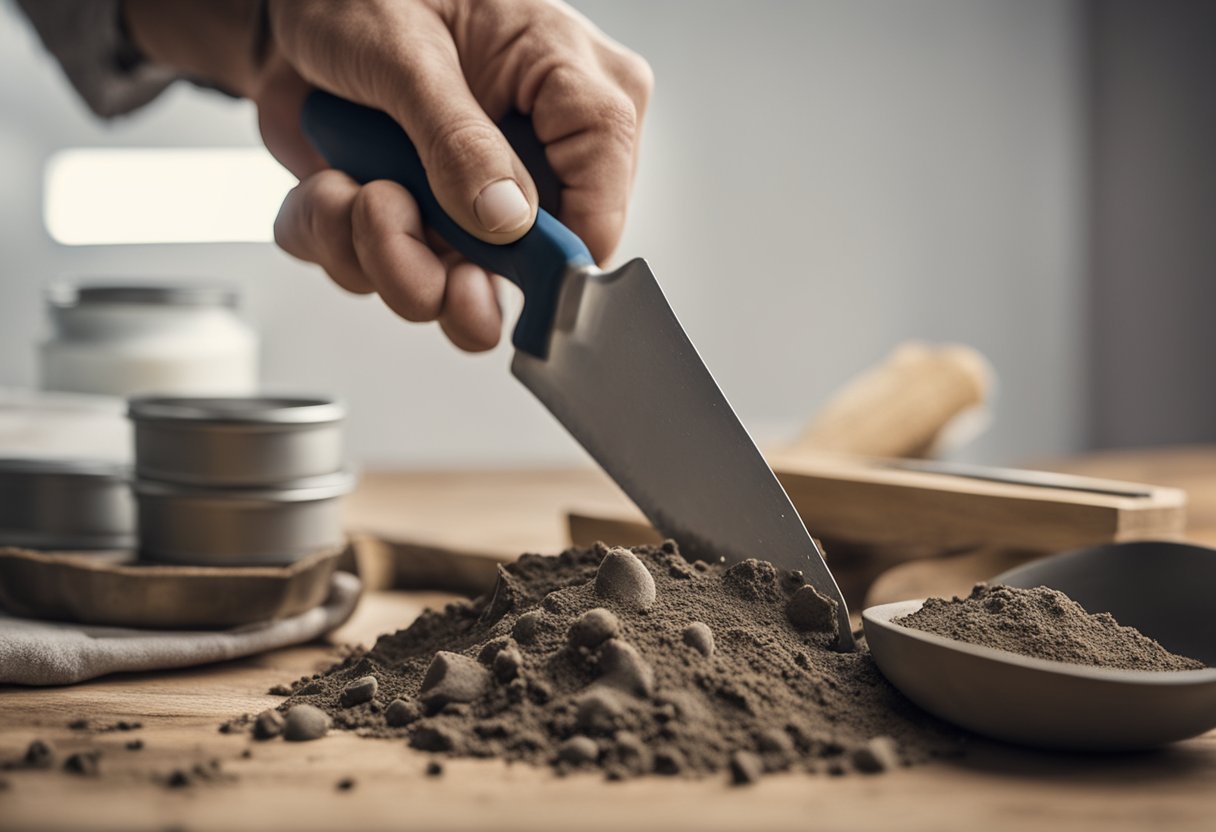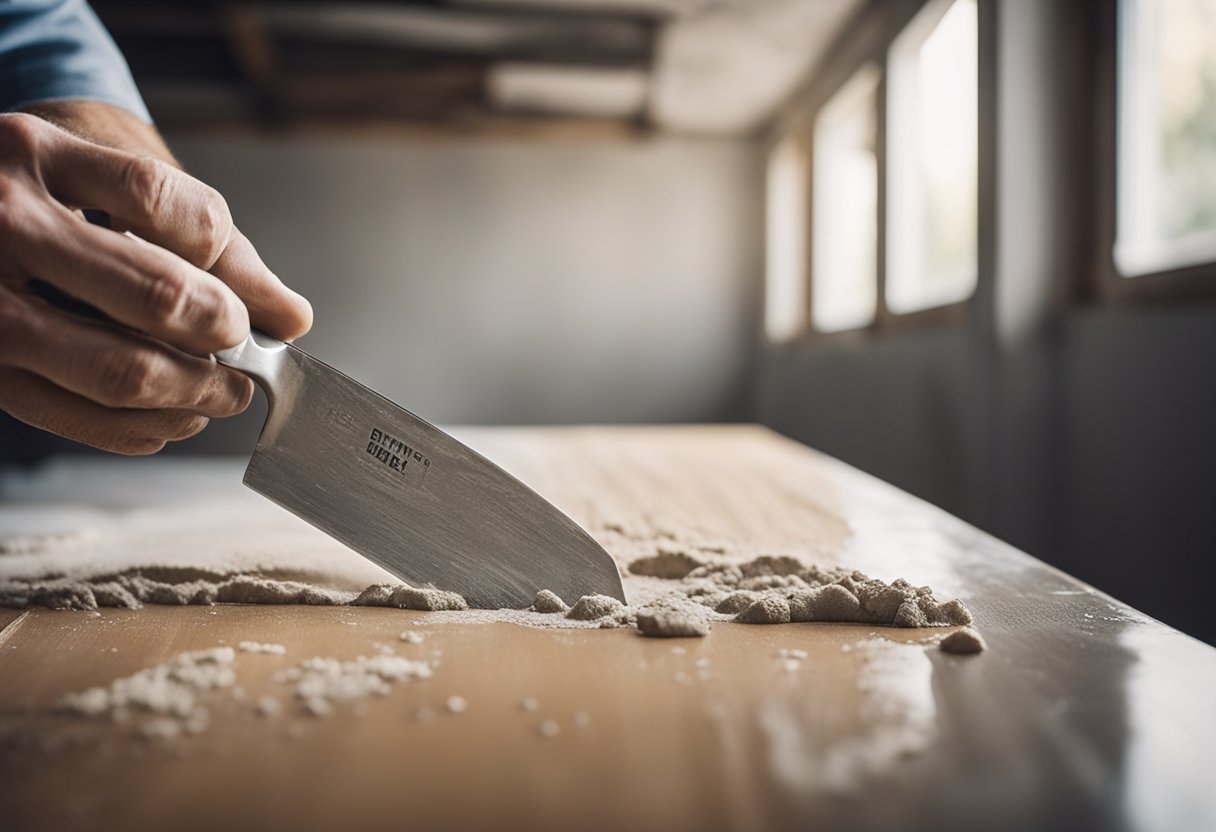Can you use drywall mud on wood? This is a common question among DIY enthusiasts, contractors, and homeowners who want to improve the look of their wooden surfaces. Drywall mud is a versatile material that is commonly used to fill gaps, cracks, and holes in drywall. However, it can also be used on wood surfaces with the right preparation and application techniques.
Understanding drywall mud is essential before applying it on wood. Drywall mud, also known as joint compound, is a gypsum-based material that is used to finish drywall joints. It comes in different types, including all-purpose, lightweight, and setting-type. While drywall mud is designed for drywall, it can also be used on wood surfaces to create a smooth and even finish. However, it is important to note that drywall mud is not intended for outdoor use, so it should not be used on wood that will be exposed to the elements.
Key Takeaways
- Drywall mud can be used on wood surfaces with proper preparation and application techniques.
- Preparation of the wood surface is crucial to ensure proper adhesion of the drywall mud.
- Drywall mud is not intended for outdoor use and should only be used in rooms with low humidity and not a lot of excess moisture.
Understanding Drywall Mud
Drywall mud, also known as joint compound, is a versatile material that is commonly used to fill and finish drywall joints and seams. It is a thick paste-like substance that is made by mixing gypsum dust with water and other additives.
When using drywall mud on wood surfaces, it is important to note that not all types of mud are suitable for the job. All-purpose mud, lightweight all-purpose mud, and setting mud are some of the most common types of drywall mud available in stores.
All-purpose mud is a general-purpose compound that can be used for a variety of tasks, including filling small holes and cracks in wood surfaces. Lightweight all-purpose mud is a lighter version of all-purpose mud that is easier to work with and dries faster. Setting mud, also known as quick-setting mud or hot mud, is a type of compound that hardens quickly and is ideal for larger projects.
When mixing drywall mud, it is important to follow the manufacturer’s instructions carefully. Most types of drywall mud require mixing with water in a bucket, and the ratio of water to mud varies depending on the type of mud being used.
Some types of drywall mud come premixed, which means that they do not require any additional mixing. Premixed mud is typically more expensive than powdered mud, but it can save time and effort.
In addition to water, drywall mud can be mixed with various additives to achieve different results. For example, some additives can be used to make the mud more durable, while others can be used to create texture or improve adhesion.
Overall, drywall mud can be a useful material for filling and finishing wood surfaces, but it is important to choose the right type of mud for the job and to follow the manufacturer’s instructions carefully.
Applying Drywall Mud on Wood
https://www.youtube.com/watch?v=hP5i4qv5jng&embed=true
When it comes to applying drywall mud on wood, it is important to prepare the surface first. This includes cleaning the surface to remove any dirt, dust, or other materials that might prevent proper adhesion. Sanding down any rough spots is also necessary to allow for a smooth finish and even surface for application.
Drywall mud can be applied to any rough-grain wood surface, including plywood or oriented strand board (OSB). However, it is important to note that drywall mud is not intended for outdoor use, so it should not be used to skim-coat a garden shed.
To apply drywall mud on wood, you will need a putty knife or trowel. For joints or seams, use a putty knife to apply a base layer of mud. Once the base layer is dry, apply a topping mud to smooth out the surface. This process is known as mudding and bedding.
It is important to note that drywall mud will not stick to wood with a high-sheen paint or wood paneling with a glossy topcoat. In these cases, it is recommended to sand down the surface or use a different type of joint compound.
Overall, drywall mud can be used on wood in certain situations. As long as the surface is properly prepared and the appropriate tools are used, applying drywall mud on wood can result in a smooth and even finish.
Preparation of Wood Surface
When it comes to applying drywall mud to wood surfaces, preparation is key to ensure proper adhesion and a smooth finish. The first step is to clean the surface thoroughly to remove any dirt, dust, or other materials that may hinder the adhesion process. I usually use a damp cloth or a vacuum cleaner to remove all the debris from the surface.
Next, it is important to sand down any rough spots on the wood surface to create an even surface for application. A rough surface can make it difficult for the mud to adhere properly, resulting in an uneven finish. I recommend using a sandpaper with a grit of 120 or higher to sand the surface.
If the wood surface is painted, it is important to note that drywall mud may not adhere well to glossy paint. However, it can be applied to a painted wood surface as long as the paint is flat and not glossy. If the wood surface is rough-grain, such as plywood or oriented strand board (OSB), then drywall mud can be applied easily.
It is also important to consider the humidity levels when applying drywall mud to wood surfaces. High humidity levels can affect the drying time of the mud, resulting in a longer drying time. In such cases, it is recommended to use a dehumidifier to reduce the humidity levels in the room.
In summary, when preparing a wood surface for drywall mud application, it is important to clean the surface, sand down any rough spots, and consider the humidity levels. By following these steps, you can ensure proper adhesion and a smooth finish on your wood surface.
Sanding and Finishing
https://www.youtube.com/watch?v=73Edmt_58qA&embed=true
When using drywall mud on wood, sanding and finishing are critical steps in achieving a smooth and even surface. Sanding the wood surface before applying the mud helps to remove any rough spots or scratches that may cause the mud to adhere unevenly or create a stippled effect. Using fine sandpaper with a grit of 220 or higher is recommended for sanding the wood surface.
After applying the drywall mud, it is essential to sand the surface again to remove any excess mud and create a smooth surface. Using a drywall sander or sanding block can help achieve a uniform finish. It is important to note that sanding too aggressively can cause scratch marks or even remove the mud completely, so it is best to sand gently and gradually until the desired finish is achieved.
In some cases, a swirled pattern or texture may be desired on the finished surface. This can be achieved by using a stippling brush or a trowel to create a swirl pattern in the mud before it dries. It is important to note that creating texture in the mud may require additional sanding and finishing to achieve a smooth and even surface.
Overall, sanding and finishing are critical steps in achieving a professional-looking finish when using drywall mud on wood. By following these steps, you can achieve a smooth and even surface that is ready for painting or other finishing techniques.
Drywall Mud as a Filler
https://www.youtube.com/watch?v=RibVrmFrySc&embed=true
As a DIY enthusiast, I have found that drywall mud can be an excellent substitute for wood filler. It can be used to fill gaps, cracks, dents, and repair holes in wood surfaces. Drywall mud is a versatile material that can be used for a variety of purposes, including patching holes for wall painting.
When working with drywall mud on wood surfaces, it’s best done by using a putty knife or trowel and ensuring that it fills in gaps, cracks, holes, and other imperfections to create an even finish afterward. After applying the mud, allow it to dry completely before sanding it down to create a smooth surface.
It’s important to note that using too much drywall mud can result in excess mud that needs to be removed. To avoid this, it’s best to apply the mud in thin layers and allow each layer to dry completely before adding another layer.
Once the mud has dried, it’s important to wipe away any excess mud using a damp cloth. This will help to create a smooth surface that is ready for sanding and painting.
Overall, drywall mud can be an excellent choice for filling gaps, cracks, dents, and repairing holes in wood surfaces. It’s affordable, easy to use, and can be found at most home improvement stores.
Drywall Mud Vs. Other Solutions
https://www.youtube.com/watch?v=Z4sEIDlBLVM&embed=true
When it comes to fixing wood surfaces, there are several solutions available, but which one is the best? In this section, I will compare drywall mud to other popular solutions and explain why drywall mud is a great option.
Drywall Mud Vs. Plaster
Plaster is a common solution for repairing walls and ceilings. It is a mixture of gypsum, water, and sand that hardens to a smooth, durable surface. While plaster can be used on wood surfaces, it is not the best option. Plaster is heavy and can crack over time, which can be problematic for wood surfaces that expand and contract with changes in temperature and humidity. Drywall mud, on the other hand, is lightweight and flexible, making it a better option for wood surfaces.
Drywall Mud Vs. Plastic Wood Filler
Plastic wood filler is a popular solution for repairing wood surfaces. It is a two-part epoxy that hardens to a durable surface. While plastic wood filler is a good option, it can be difficult to work with, especially for larger repairs. It also takes a long time to dry and can shrink as it dries, which can result in cracks. Drywall mud, on the other hand, is easy to work with and dries quickly. It also does not shrink as it dries, which means fewer cracks.
Drywall Mud Vs. Concrete
Concrete is a great option for repairing floors and outdoor surfaces. It is durable and can withstand heavy foot traffic and weather. However, it is not a good option for wood surfaces. Concrete is heavy and can crack over time, which can be problematic for wood surfaces that expand and contract with changes in temperature and humidity. Drywall mud, on the other hand, is lightweight and flexible, making it a better option for wood surfaces.
Drywall Mud Vs. Drywall Compound
Drywall compound, also known as joint compound, is a popular solution for repairing drywall surfaces. It is a mixture of gypsum, water, and other additives that harden to a smooth surface. While drywall compound can be used on wood surfaces, it is not the best option. Drywall compound is heavy and can crack over time, which can be problematic for wood surfaces that expand and contract with changes in temperature and humidity. Drywall mud, on the other hand, is lightweight and flexible, making it a better option for wood surfaces.
In conclusion, drywall mud is a great option for repairing wood surfaces. It is lightweight, flexible, easy to work with, and dries quickly. It is also a versatile compound that can fill holes, cracks, and other imperfections in wood surfaces. While there are other solutions available, drywall mud is the best option for wood surfaces.
Cautions and Recommendations
When using drywall mud on wood, there are a few cautions and recommendations to keep in mind.
Firstly, it’s important to note that drywall mud is not intended for outdoor use. Therefore, it should not be used on wood surfaces that will be exposed to the elements.
Moisture can also be a concern when using drywall mud on wood. If the wood is not properly prepared and sealed, it can absorb moisture from the mud and cause it to crack or shrink over time. To avoid this, it’s recommended to use a white primer on the wood before applying the mud.
It’s important to note that drywall mud can be thick and difficult to work with, especially for DIYers who are not experienced with the material. To make it easier to apply, it can be thinned with water. However, be careful not to thin it too much as this can cause it to drip and not adhere properly.
When applying drywall mud to wood, it’s recommended to apply it in thin layers, allowing each layer to dry overnight before applying the next. This will help prevent shrinkage and cracking.
Lastly, it’s important to choose the right thickness of drywall mud for the job. A thicker mud may be necessary for filling larger gaps, while a thinner mud can be used for smaller imperfections.
By following these cautions and recommendations, you can successfully use drywall mud on wood surfaces.
Special Tools and Materials
When using drywall mud on wood, it is important to have the right tools and materials on hand to ensure a smooth and successful application. Here are some of the special tools and materials that I recommend:
Paper Joint Tape or Mesh Joint Tape
When applying drywall mud to wood, it is important to reinforce the joints with paper joint tape or mesh joint tape. This will help prevent cracking and ensure a strong, long-lasting finish. Paper joint tape is a good choice for flat joints, while mesh joint tape is better for corners and curves.
Metal Corner Beads
If you are working with outside corners, it is a good idea to use metal corner beads to reinforce the joint. This will help prevent cracking and ensure a smooth finish. Metal corner beads are available in a variety of sizes and can be easily installed with drywall screws or nails.
Top Paper
When using drywall mud on wood, it is important to use a top paper to help create a smooth, even surface. Top paper is a thin, flexible paper that is applied over the drywall mud and sanded to create a smooth finish. It is available in a variety of sizes and can be easily cut to fit the size of your project.
Drywall Sander
A drywall sander is an essential tool for sanding down drywall mud on wood. It is available in both manual and electric versions and can be used to quickly and easily sand down rough spots and create a smooth finish.
Paint Roller or Paintbrush
When applying drywall mud to wood, it is important to use a paint roller or paintbrush to ensure an even application. A paint roller is a good choice for large, flat surfaces, while a paintbrush is better for smaller areas and corners.
Drill
If you are installing drywall on wood, it is important to use a drill to secure the drywall to the wood. A drill can also be used to create holes for electrical outlets and other fixtures.
In addition to these special tools and materials, you will also need basic tools such as a utility knife, measuring tape, and a straight edge. With the right tools and materials, you can successfully use drywall mud on wood to create a smooth, professional finish.
Frequently Asked Questions
Can you use joint compound on exterior wood?
No, joint compound or drywall mud is not suitable for exterior wood surfaces. It is not designed to withstand the harsh outdoor elements and will not hold up over time. Using joint compound on exterior wood may result in cracking, peeling, or other damage.
Can you use joint compound on wood trim?
Yes, joint compound can be used on wood trim. However, it is important to note that joint compound is not as durable as wood filler. If the wood trim is subject to a lot of wear and tear, it may be better to use wood filler instead of joint compound.
Wood filler vs joint compound – which is better for wood?
Wood filler is generally better suited for wood than joint compound. Wood filler is specifically designed for use on wood surfaces and is more durable than joint compound. Wood filler is also better at filling larger gaps and holes in wood than joint compound.
Can you use drywall mud on particle board?
Yes, you can use drywall mud on particle board. However, it is important to note that particle board is a porous material and may require multiple coats of drywall mud to achieve a smooth finish. It is also important to properly prepare the particle board surface before applying the drywall mud.
Can you use drywall tape on wood?
Yes, you can use drywall tape on wood. Drywall tape can be used to reinforce joints and seams in wood surfaces. However, it is important to note that drywall tape is not as durable as wood-specific tape and may not hold up as well over time.
Can you mud over wood with drywall mud?
Yes, you can mud over wood with drywall mud. However, it is important to properly prepare the wood surface before applying the drywall mud. The wood surface should be clean, dry, and free of any loose debris or paint. Additionally, it may be necessary to apply a primer to the wood surface before applying the drywall mud.

Hi, I’m Sal Muller of Tooltrip.com. My DIY experience led me to understand essential power tools for home projects. Tooltrip.com guides enthusiasts and professionals in choosing right tools for any job. I provide concise top tool reviews for easier, efficient DIY.

